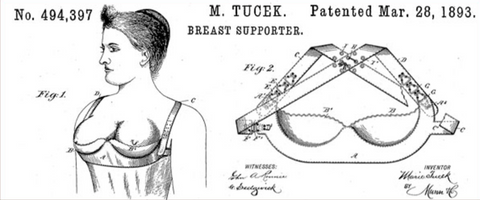It’s become apparent to me as I have fitted many different women of all sizes through the development process of the Videris softcup bras that we as women often associate being supported with being uncomfortable. That a comfortable bra felt odd and like it wasn’t doing it’s job. Where have we got this idea from? The wired bra is the last vestige of the corset which was used to re-shape women's hips, waists and busts. Will we eventually eliminate the underwire and wear soft cup bras that allow our breasts to sit naturally as we now allow our tummies?
The corset was introduced in the 16th century, forever changing the shape and expectations of womens’ bodies and remained the foundation of a woman's wardrobe until the 1800’s. In 1869 Hermione Cadolle adapted the corset by cutting it into 2 pieces creating what would come to be known as the bra and waspie, this coincided with the thinking in the 1870s that oppressive clothing that controlled a woman's body also brought about the necessary subjection of the mind, linking the wearing of a corset with women not having the right to vote and a prelude to the symbol that the wired bra would represent for the women’s rights movements in the 1960s and 70s.

Despite the extreme discomfort and now obvious health issues created by the corset it was the advent of World War I and women entering the workforce for the first time that led to the adoption of the ‘bra’ as we know it today, women realised the corset was no longer a practical option when working.
In the 1960s and 1970s a more ‘natural’ look was sought after in line with the women’s rights movement where the bra was a symbol of oppression and chauvinism. Ironically the bra-less look was most often achieved with the help of a wired bra and it remained a part of women's wardrobes and still does today. Although there have been innovations in fabrics and components; stretch fabrics, elastics, foam padding, updated wire shapes and trims, the founding elements of Marie Tuceks 1893 patent are still prevalent.
I read a quote recently; “As the modern woman has evolved over the last one hundred years, the metamorphosis of the bra is a reflection of that transformation.” I disagree, women have evolved but the essence of the bra has not. It is still restrictive, it is still uncomfortable and there is still an expectation from society that women wear one. Whilst I don’t think there is still the subjection of the mind that the corset of the 1870s was thought to bring about I do think there is control placed over our bodies by the wire; we are all familiar with the 3pm feeling where the effects of the wire pressure on the diaphragm begins to become uncomfortable and we are looking forward to that moment when we can get home and take it off!
There have been small shifts, we are moving away from a padded silhouette, we are starting to realise that the ‘support’ offered by the wire is not necessary. We are embracing the natural shape of our breasts as we embraced the shape of our waists and hips in the early 1900’s when we ditched the corset. We don’t feel like we have to hide the shape or indent of our nipples.
I don’t believe we need to get rid of the bra entirely, just change our relationship with it. I enjoy wearing underwear and I enjoy wearing a soft cup bra, Every woman is different, each breast is different (even between a pair!) and they change throughout our cycle. Wearing a non-wired bra which offers comfort, support and flexibility in fit whilst celebrating our natural shape is the best thing for us.
Much Light
Chloé x